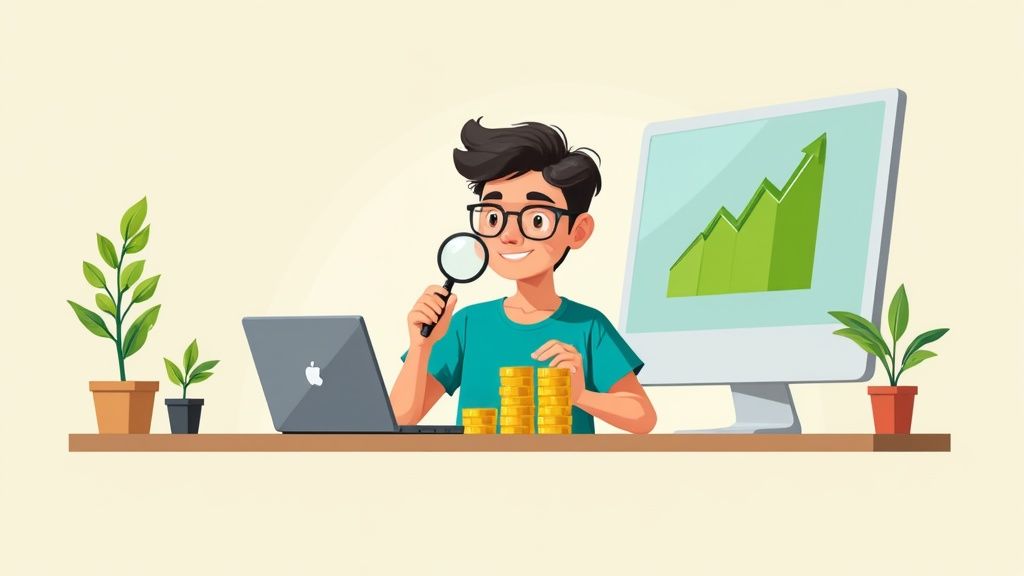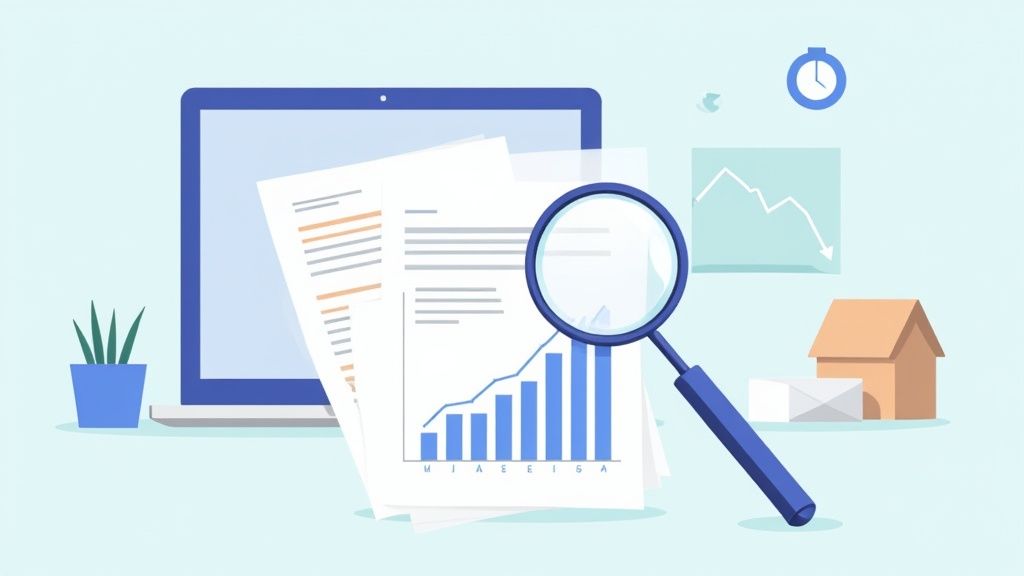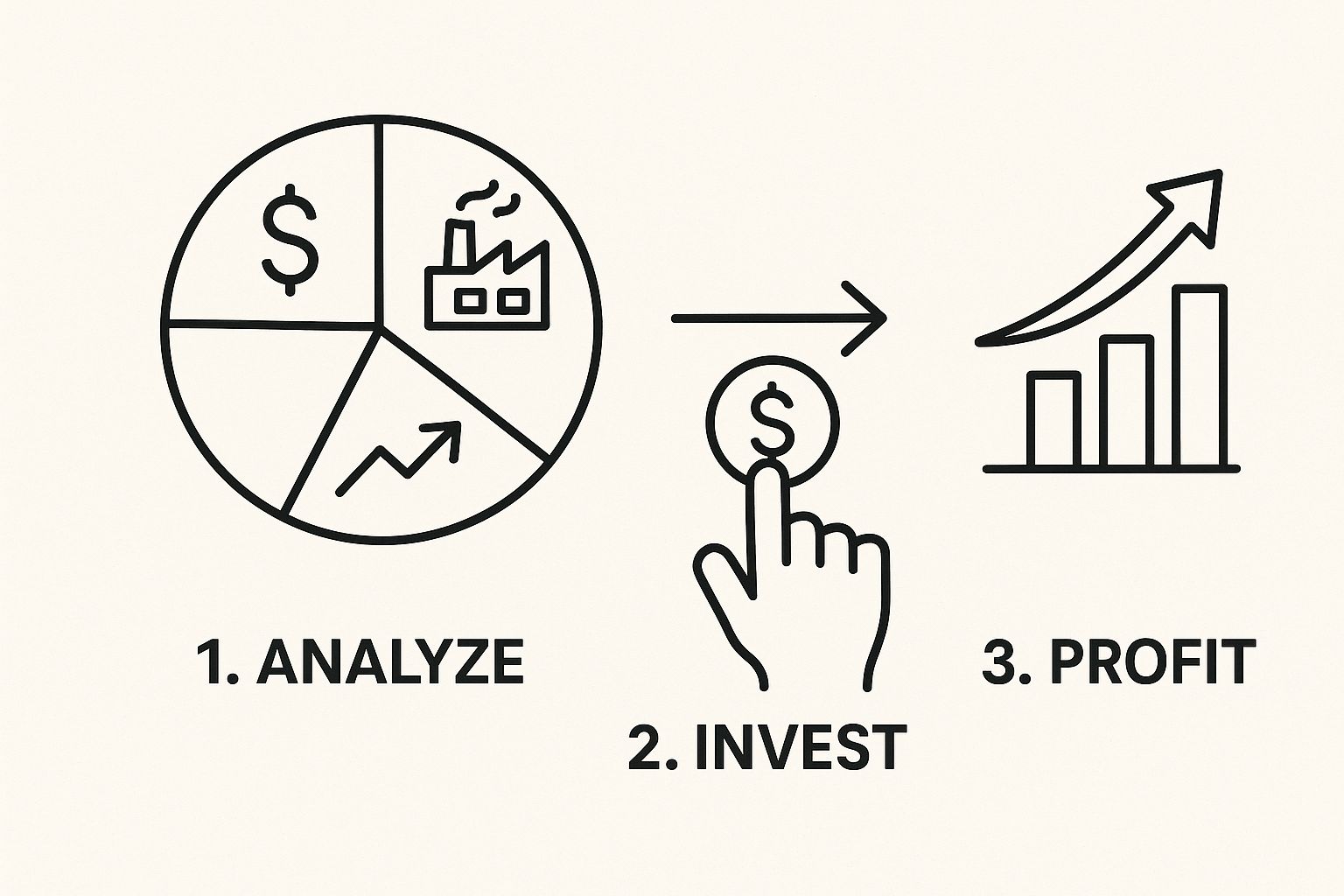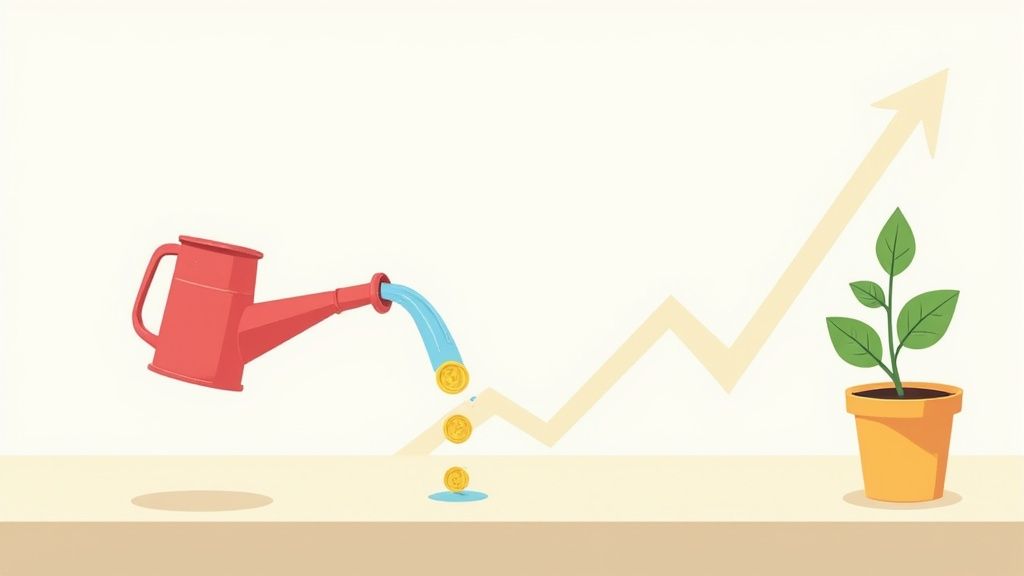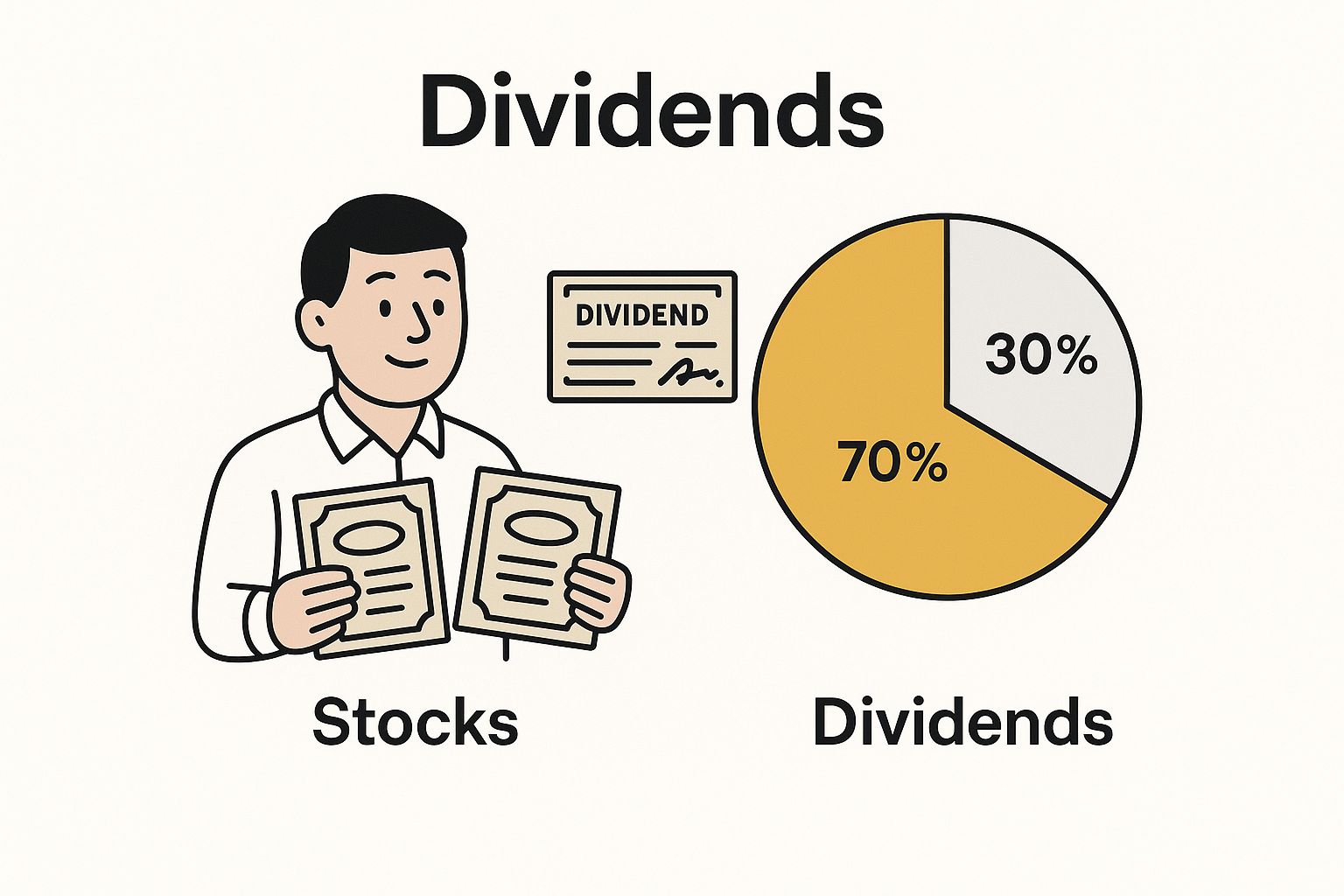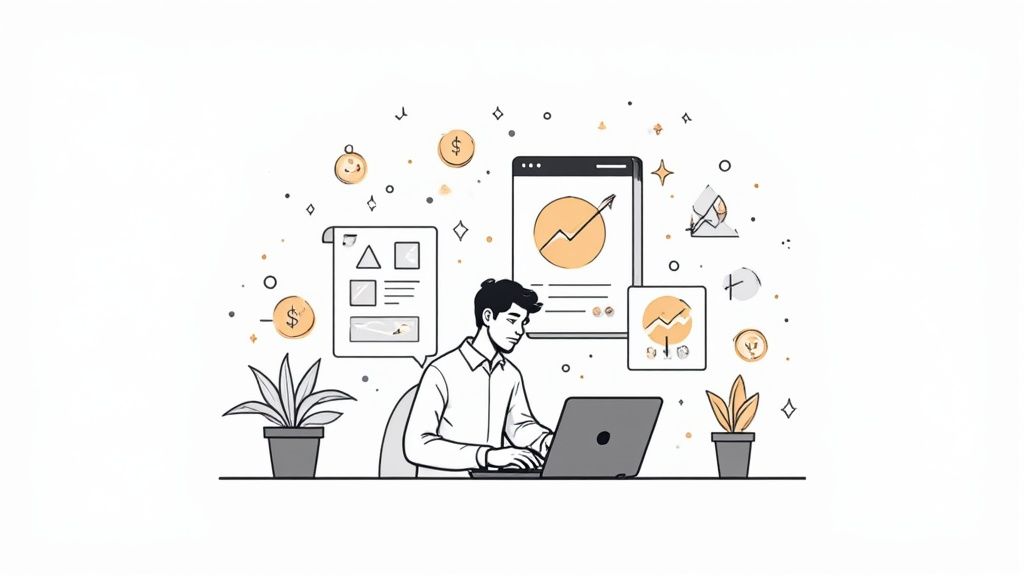So, you want to get into dividend investing? Smart move. Think of it like this: you find solid, stable companies that share their profits with you, their part-owner. But it's not just about chasing the biggest paycheck. The real skill is learning to spot companies that can reliably pay and grow those payouts over time. It’s about looking at the big picture of a company's financial health, not just a flashy number.
What Are Dividend Stocks And Why They Matter
Ever wonder how people make money from stocks without selling them? Welcome to the world of dividend stocks.
Imagine a dividend as a cash "thank you" note that a company sends you just for being a shareholder. When a business like Coca-Cola or Apple makes a profit, they can either pour all that cash back into growing the company or share a slice of the pie with their owners. That slice is the dividend. For you, this can become a steady stream of income, like getting paid for doing nothing.
The Real Power Behind Dividends
Don't mistake dividends for just a small bonus. They are a massive engine for building wealth. History makes this crystal clear. Since 1926, dividends have been responsible for about 31% of the S&P 500's total return. That means almost a third of the stock market's long-term gains came from these simple cash payments.
In really rocky decades, like the 1930s, that income was an even bigger deal, providing a much-needed cushion for investors. If you want to dive deeper, S&P Global has some fascinating research on the historical power of dividends.
This power gets supercharged by something Albert Einstein supposedly called the "eighth wonder of the world": compounding. This is where your money starts making its own money. Instead of pocketing your dividend cash, you can reinvest it to buy more shares. Those new shares then earn their own dividends, which you can use to buy even more shares. It’s a powerful snowball effect that just keeps getting bigger.
"Compound interest is the eighth wonder of the world. He who understands it, earns it… he who doesn't… pays it." – A quote often attributed to Albert Einstein
This isn't some complex strategy for Wall Street pros. It's a simple, accessible way for anyone to build serious wealth over time, even if you're just starting out.
Key Benefits of Dividend Investing at a Glance
Here’s a quick rundown of why focusing on dividend stocks can be a game-changer for your financial future.
| Benefit | Why It Matters for You |
|---|---|
| Passive Income Stream | Get paid regular cash just for owning a piece of a company. Use it for pizza money or to buy more stock. |
| Indicator of Company Health | A consistent, growing dividend is a strong signal of a stable, well-managed business that's confident about its future. |
| Reduces Portfolio Volatility | That steady dividend income can help soften the blow when the stock market gets wild and prices are down. |
| Fuels Compounding | Reinvesting dividends is the secret sauce to making your portfolio grow faster without putting in more of your own cash. |
These benefits work together to create a strong and resilient investment strategy.
Why You Should Care About Dividend Stocks
For young investors especially, getting familiar with dividend stocks now can set you up for huge financial wins down the road. They offer a powerful combination of perks that are perfect for building a solid foundation.
- Creates Passive Income: Dividends give you a regular cash flow. Think of it as getting paid just for owning an asset. You can use it to cover bills or, even better, reinvest it to make your portfolio grow faster.
- Shows Company Health: A business that consistently pays and, ideally, increases its dividend is usually on solid financial ground. It’s a huge green flag that the management team is disciplined and optimistic about the future.
- Reduces Risk: The income you get from dividends can act as a buffer for your portfolio's value, especially during market downturns when stock prices might be falling.
- Powers Compounding Growth: As we mentioned, reinvesting your dividends is one of the most effective ways to accelerate wealth-building without having to constantly find new money to invest.
Learning to pick the right dividend stocks is a skill that can literally pay off for decades, helping you build a financial safety net and hit your long-term goals.
The Numbers That Really Matter for Dividend Stocks
Jumping into stock analysis can feel like learning a new language, full of jargon and confusing numbers. But here's the good news: you only need to master a few key stats to get a real feel for a company's health.
Let's break down the most important numbers that tell the true story behind a great dividend stock.
Dividend Yield: The 'Right Now' Number
The first thing everyone notices is the dividend yield. It’s a simple percentage that answers the question: "How much cash will I get back this year for every dollar I invest?" If a stock costs $100 and pays out $3 in dividends annually, its yield is a simple 3%.
A high yield can be tempting, but be careful. A crazy-high number is often a warning sign-what investors call a "dividend trap." It can mean the stock price has fallen hard because the market thinks the company is in trouble and might have to cut that dividend soon.
Chasing a big yield without looking under the hood is one of the fastest ways to lose money.
Payout Ratio: The 'Can They Afford It?' Test
This brings us to the payout ratio, which is my go-to reality check. This number tells you what percentage of a company's profits is being paid out to shareholders as dividends. It’s like checking your friend's bank account before they offer to buy everyone dinner-you want to know they can actually afford it.
A very low ratio, say under 20%, means the company is reinvesting heavily in itself, which is often a good sign for future growth. On the flip side, a ratio creeping over 80% could be a red flag. It suggests the company is stretching its finances, leaving very little room for error if profits drop.
A healthy payout ratio, typically between 30% and 60% for most established companies, strikes the perfect balance. It shows a real commitment to rewarding shareholders while keeping plenty of cash on hand to grow the business and handle tough times.
Dividend Growth Rate: The 'Will I Get a Raise?' Clue
Last but not least is the dividend growth rate. For long-term investors, this is arguably the most powerful number of all. It shows the year-over-year increase in a company's dividend payments. Think of it like this: a company that consistently gives its shareholders a "raise" is showing a huge amount of confidence in its future.
This is the secret sauce for building wealth over time. It's the difference between a static income and one that grows, compounding your returns year after year. To get a full picture of a company's financial strength, it helps to know how to analyze financial statements like a pro.
History proves the power of this approach. Take the S&P 500 Dividend Aristocrats-an exclusive club of companies that have increased their dividends for at least 25 consecutive years. These stocks have historically delivered higher average yields (around 2.5%) than the broader S&P 500 (around 1.8%). This isn't just about income; it's about quality and consistency.
Essential Dividend Metrics Explained
Use this quick reference guide to understand the most important financial numbers for any dividend stock.
| Metric | What It Tells You | Healthy Range |
|---|---|---|
| Dividend Yield | The annual dividend per share divided by the stock's current price. It's your immediate return. | Varies by industry, but be wary of yields above 6-7% as they can signal high risk. |
| Payout Ratio | The percentage of company profits paid out as dividends. It measures sustainability. | 30% to 60% is a good sweet spot for stable companies. REITs and MLPs are exceptions. |
| Dividend Growth Rate | The annualized percentage of growth in a company's dividend over time. It signals confidence. | Look for consistent growth of 5% or more annually, ideally outpacing inflation. |
Wrapping your head around these three numbers will put you miles ahead of the average investor. They provide a simple yet powerful framework for finding quality companies that don't just pay you today, but are likely to pay you even more tomorrow.
Look Beyond the High Yield for Truly Great Companies
That juicy, high dividend yield might catch your eye, but be careful. It can sometimes be the investing equivalent of fool's gold. I’ve seen it happen too many times: a struggling company dangles a big payout right before its stock price tanks. That’s a classic "dividend trap," and it’s a painful lesson to learn.
To really get good at picking dividend stocks, you have to become a bit of a financial detective.
This means looking past that shiny yield number and digging for signs of a truly healthy, durable business. You're not just looking for a quick score; you're trying to find a reliable, all-star player for your long-term team.
Find Companies With a Strong "Moat"
Warren Buffett, one of the greatest investors of all time, has a brilliant way of thinking about this. He looks for companies with a strong "economic moat"-a powerful competitive advantage that protects them from rivals. It’s like owning a castle surrounded by a deep, wide moat filled with crocodiles.
"The key to investing is not assessing how much an industry is going to affect society, or how much it will grow, but rather determining the competitive advantage of any given company and, above all, the durability of that advantage." – Warren Buffett
So, what makes a company almost untouchable? It usually comes down to a few things:
- Brand Power: Think about why people willingly pay a premium for Nike shoes or an Apple iPhone. It’s not just the product; it’s the brand. That intense customer loyalty is a huge moat.
- Network Effects: Platforms like Instagram or TikTok become more valuable as more people join. Once a network reaches a certain size, it’s incredibly difficult for a new competitor to lure users away. Everyone is already in one place.
- Switching Costs: If your entire business runs on Microsoft software, the thought of switching to a new system is probably a massive, expensive headache. That difficulty in leaving is a powerful, protective moat.
When a company has a wide moat, it can defend its profits for years, which is exactly what you want for a steady stream of dividend income. It gives the business real pricing power and a foundation for long-term stability.
Check for Healthy Finances
A company's moat protects it from the outside world, but you also need to pop the hood and make sure the engine is running smoothly. A couple of quick checks can tell you a lot about a company's financial strength and its ability to keep those dividend checks coming.
First, take a look at its profitability. Is the company consistently making money? Better yet, are its profits growing over time? A quick glance at a company's revenue and net income trends over the past five years on a site like Yahoo Finance can be incredibly revealing. You're looking for a steady upward climb, not a wild rollercoaster ride.
Second, check its debt levels. A mountain of debt can sink even the most promising businesses when things get tough. A handy metric here is the debt-to-equity ratio. While what's "good" can vary by industry, a ratio below 1.0 is generally a sign of a very healthy balance sheet. High debt is a red flag because it can put dividend payments on the chopping block if the company hits a rough patch.
How to Find Great Dividend Stocks for Free
Alright, enough with the theory. Let's get our hands dirty and figure out how you can actually find these gems without getting lost in thousands of stock tickers. The best tool for the job is a stock screener, and thankfully, you can find some excellent ones for free.
Think of it like using a filter on an online store. You wouldn't scroll through every single shirt; you'd narrow it down by size, color, and price. A stock screener does the same thing for the stock market, letting you zero in on companies that match your exact criteria.
This process essentially takes the entire universe of stocks and funnels it down to a manageable list of candidates worth a closer look.
It’s all about applying smart filters to sift out the junk and focus on quality and safety.
Using a Free Stock Screener
Fantastic, free screeners are available on websites like Yahoo Finance and Finviz. These tools are your best friend because they let you plug in the exact metrics we've been talking about, instantly creating a shortlist of potential winners. It's a massive time-saver.
If you're looking for a starting point, checking out curated lists of the best dividend stocks to buy can also give you a feel for what seasoned investors are keeping an eye on.
Let's walk through setting up a simple screen on Finviz right now. We'll tell the tool exactly what we're looking for, using the healthy numbers we've already covered. This is your first real step toward actively picking great dividend stocks.
Here are the filters I'd start with to hunt for solid companies:
- Dividend Yield: I'd set this to "Over 2%." This immediately gets rid of companies paying next to nothing, but it also helps us avoid those suspiciously high, often unsustainable yields.
- Payout Ratio: Let's go with "Under 60%." This is a crucial safety check. It tells us the company isn't stretching its finances too thin just to pay us, leaving a healthy cushion.
- Debt/Equity: I always look for "Under 1.0." This filter helps weed out businesses that are buried under a mountain of debt, which can put a dividend at risk during tough times.
Just by plugging in these three simple rules, you can shrink a list of over 8,000 stocks to a much more focused, manageable handful. That’s the power of a good screener.
My Two Cents: Don't feel like you have to stop with just these three filters. Once you get the hang of it, start layering in others. You could add a filter for positive dividend growth over the past five years or screen for a minimum company size (market cap) if you prefer to stick with bigger, more established players.
From a List to Your First Pick
Once the screener works its magic, you'll have a list of companies that made the cut. This is where the real fun-the detective work-begins.
Now it's time to dig into each company one by one. Check out their website. What do they actually do? Does their business model make sense to you? This is also where you should bring back that "moat" concept we talked about earlier. Does this company have a real, durable advantage over its competitors?
Ask yourself: "Is this a business I truly understand and would be happy to own for the long haul?"
If the answer is a big "yes," then you might have just found a fantastic addition to your dividend portfolio. This simple, repeatable process is exactly how you can consistently find quality investments without paying for expensive software.
Your Wealth-Building Superpower: Reinvesting Dividends
Ready for the secret sauce of dividend investing? It’s a beautifully simple idea called dividend reinvestment, and it’s the key to putting your portfolio’s growth on autopilot.
Instead of taking your dividend payments as cash, you can tell your brokerage to automatically buy more shares of the very stock that paid you. Think of it this way: even business icons like Shaquille O'Neal love businesses that generate steady cash flow. Reinvesting is how you turn that flow into a flood.
This simple move creates an incredible snowball effect that gathers serious momentum over time.
The Magic of Compounding in Action
The process itself is wonderfully simple. Your original shares earn dividends. Those dividends then buy you more shares (often just fractions of a share, which is perfect). The next time the company pays a dividend, you get paid on your original shares plus the new ones you just bought.
This cycle repeats itself over and over. Your growing number of shares earns more dividends, which buys even more shares, which then earns even more dividends. It's a self-feeding loop that can dramatically speed up your long-term returns.
"The first rule of compounding is to never interrupt it unnecessarily." – Charlie Munger
Don't mistake this for some small trick to squeeze out a few extra bucks. Over decades, this one strategy is powerful enough to turn a modest, regular investment into a serious pile of cash. It’s about as close as you can get to a wealth-building cheat code.
A Tale of Two Investments
To see just how powerful this is, let's run through a quick story. Imagine two friends, Alex and Ben, each invest $10,000 into the same dividend stock. This stock has a solid 4% yield, and let's say its price grows by a steady 5% each year.
- Ben takes the cash dividend every quarter and spends it. After 20 years, his initial investment grows to a respectable $26,533. Not bad.
- Alex reinvests every single dividend. Her same $10,000 investment explodes to over $58,155 in the same 20-year period.
That's more than double Ben's result, all from flipping a single switch in her brokerage account. This isn't just a made-up story, either. Real-world data shows that dividend reinvestment is an absolute game-changer. For example, an S&P 500 tracking fund that automatically reinvested dividends grew an initial investment by an incredible 1,856% in inflation-adjusted terms from 1986 to 2024. You can find more data on the power of reinvesting at totalrealreturns.com.
Setting this up is usually super easy. Most brokers call it a Dividend Reinvestment Plan, or DRIP, and turning it on is often as simple as checking a box in your account settings. It’s a classic "set it and forget it" move that lets the power of compounding do all the heavy lifting for you.
A Few Common Pitfalls to Sidestep
Look, everyone messes up when they're starting out. Investing is no different. But if you know where the common traps are, you can often step right over them. Let's talk about a few classic rookie mistakes in dividend investing so you can avoid them from day one.
The Siren Song of High Yields
One of the biggest traps new investors fall into is yield chasing. It's easy to get starry-eyed when you see a stock with a 10% dividend yield. It sounds incredible, right? But you have to ask why the yield is that high.
More often than not, a sky-high yield is a massive red flag. It usually means the company is in trouble and its stock price has crashed, which artificially inflates the yield number. It's a classic "yield trap" that often ends with a painful dividend cut, leaving you with a loss.
All Your Eggs, One Fragile Basket
Another mistake is forgetting to diversify. I get it. You find one company you absolutely love, you've done the research, and you want to go all-in. But even the best-run companies can hit unexpected problems.
"The only investors who shouldn't diversify are those who are right 100% of the time." – John Templeton
A good rule of thumb is to spread your money across 10-20 different stocks. Make sure they're in different industries, too-think tech, healthcare, consumer goods, and utilities. That way, if one part of the market is having a bad year, your other investments can help cushion the blow.
Selling in a Panic
This last one is probably the most destructive mistake you can make: panicking when the market dips. Your gut reaction when you see your portfolio value drop is to sell everything to stop the pain. It’s a totally human feeling.
But the most successful investors have learned to fight that urge. They see market downturns not as a crisis, but as a sale. It’s your chance to buy more shares of fantastic companies at a bargain price. Sticking to your plan during the tough times is what separates the pros from the amateurs.
Got Questions About Dividend Investing? Let's Get Them Answered
It's totally normal to still have a few questions. Honestly, the best investors are the ones who never stop asking. Let's tackle some of the most common questions I hear from people just starting out with dividend stocks.
How Many Dividend Stocks Is The "Right" Number?
There’s no magic number here, but a good target to aim for is somewhere between 10 and 20 stocks.
The real key, though, isn't the number itself-it's diversification. You want those stocks spread across different parts of the economy, like tech, healthcare, and consumer goods. Think of it as a safety net; if one industry hits a rough patch, your entire portfolio doesn't go down with it. My advice? Start small with one or two companies you've really researched, and then gradually build from there.
Will I Owe Taxes On My Dividends?
Yep, you almost certainly will. The government views dividends as taxable income, and the rate you pay depends on your income and the type of dividend.
But here's a pro tip that can make a massive difference over time: use a tax-advantaged account. If you hold your dividend stocks in an account like a Roth IRA, those payouts can grow 100% tax-free. It's one of the most powerful ways to supercharge your long-term returns.
A huge part of investing is simply knowing the rules of the game. If you want to build a rock-solid foundation, this free online stock trading course does a great job covering these essentials.
Should I Focus on Dividend Yield or Dividend Growth?
Ah, the classic debate. It really comes down to what you're trying to achieve.
Dividend yield is all about the "right now"-it's a snapshot of the cash return you're getting today. Dividend growth, on the other hand, is about the future. It shows you the company's track record of increasing its payout to shareholders year after year.
From my experience, a company with a lower yield but a consistent history of raising its dividend is often a much better long-term bet. A high-yield stock might look tempting, but if that payout isn't growing, your income stream is stagnant. Growth is the engine that will truly power your wealth for years to come.
Ready to put your knowledge into practice? Finance Illustrated offers a suite of free tools, simulators, and bite-sized lessons designed to make you a smarter, more confident investor. Explore our resources and start your journey at https://financeillustrated.com.
